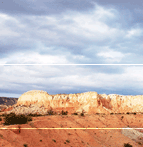The Rich History of Plaza Blanca and Abiquiu
The stunning landscape around Plaza Blanca represents millions of years of geological history and thousands of years of human presence, creating a rich tapestry of natural formation, indigenous culture, Spanish colonial influence, and modern artistic inspiration. Understanding this deep history enhances appreciation for both the remarkable formations and the cultural significance that has drawn people to this special place for generations.
Geological Origins: Millions of Years in the Making
Ancient Seabeds to Desert Formations: The dramatic white cliffs and spires of Plaza Blanca began forming approximately 200 million years ago during the Triassic period, when this region lay beneath ancient seas. Layers of marine sediments, primarily limestone and sandstone, accumulated over vast periods, eventually being uplifted and exposed through the ongoing geological processes that continue to shape the Colorado Plateau.
Erosional Sculpting: The distinctive formations we see today result from millions of years of wind and water erosion working on the varied resistance of different rock layers. The softer sedimentary rocks eroded more quickly, creating the dramatic spires, alcoves, and sculptural forms that captivate modern visitors. This ongoing process means the formations continue to evolve, though at rates imperceptible to human timescales.
The Chama River's Role: The meandering Chama River has played a crucial role in exposing and shaping these formations by cutting through the landscape and providing the erosional forces necessary to reveal the buried limestone layers. The river's changing course over millennia created the valley system that now provides access to Plaza Blanca and the surrounding attractions.
Indigenous Heritage: Ancestral Puebloan Legacy
Early Inhabitants: Archaeological evidence indicates human presence in the Abiquiu region dating back over 1,000 years, with Ancestral Puebloan peoples establishing permanent settlements by 1200 CE. These sophisticated agricultural societies developed complex irrigation systems, created stunning pottery and artwork, and built substantial pueblo communities that housed hundreds of residents.
Poshuouinge: Window into Ancient Life
Major Archaeological Site: Just 2.5 miles south of modern Abiquiu, the ruins of Poshuouinge (pronounced "poe-shoo-wing-gay") represent one of the most significant archaeological sites in northern New Mexico. This large ancestral Tewa pueblo was occupied from approximately 1375 to 1475 CE, housing an estimated 1,500 inhabitants at its peak.
Sophisticated Society: Poshuouinge demonstrates the advanced social organization, agricultural techniques, and artistic achievements of late-period Ancestral Puebloan culture. The pueblo featured multi-story buildings, ceremonial plazas, and evidence of extensive trade networks that brought materials from across the Southwest. The site's location provided access to diverse ecological zones, enabling residents to practice sophisticated resource management strategies.
Mysterious Abandonment: Like many Ancestral Puebloan sites, Poshuouinge was abandoned around 1475 CE, just before Spanish contact. The reasons remain debated by archaeologists but likely involved climate change, resource depletion, social upheaval, or combinations of these factors. The site's preservation provides crucial insights into late prehistoric Southwestern cultures.
Spanish Colonial Period: Cultural Transformation
Early Spanish Exploration: Spanish explorers first entered the Abiquiu region in the late 16th century as part of the broader colonization of the upper Rio Grande valley. The area's strategic location along trade routes and its agricultural potential quickly attracted Spanish attention, though initial settlement efforts faced numerous challenges from both environmental conditions and indigenous resistance.
Settlement of Santa Rosa de Lima de Abiquiú
Official Founding: Spanish and Genízaro settlers officially established Santa Rosa de Lima de Abiquiú in 1744, building their community directly atop the ruins of the prehistoric Tewa pueblo P'efu. This pattern of settlement on ancient sites was common throughout the region, as these locations often provided access to water, agricultural land, and defensible positions.
Genízaro Communities: Abiquiu became an important center for Genízaro populations - detribalized indigenous peoples who had been captured, traded, or voluntarily joined Spanish colonial society. These communities formed a crucial bridge between indigenous and Spanish cultures, developing unique traditions that blended elements from both worlds while creating something entirely new.
Agricultural Development: Spanish colonists introduced new crops, livestock, and agricultural techniques while learning to adapt to the high desert environment. The acequia (irrigation ditch) system, still visible today, enabled reliable agriculture in this challenging climate and supported growing communities throughout the Chama River valley.
Mexican Period and Territorial Era
Mexican Independence Impact: Following Mexican independence in 1821, the Abiquiu region experienced increased trade along the Old Spanish Trail, which connected Santa Fe to Los Angeles. This commerce brought new prosperity but also increased conflict with Navajo, Ute, and other indigenous groups who continued to assert territorial claims.
Land Grant Complications: The complex system of Spanish and Mexican land grants created lasting confusion about property ownership that continues to affect the region today. Many current land ownership patterns, including the private ownership of Plaza Blanca, trace back to these colonial-era grants and their often imprecise boundaries.
The Modern Era: From Obscurity to Fame
Georgia O'Keeffe's Discovery and Artistic Legacy
First Encounters: While Plaza Blanca had existed in relative obscurity for centuries, it gained international recognition through the paintings of Georgia O'Keeffe, who first visited the region in 1929. She was immediately captivated by the area's dramatic landscapes, unique light conditions, and the interplay between natural and artificial forms that characterized the high desert environment.
Early Artistic Exploration: During her initial visits, O'Keeffe focused on various regional subjects, including the famous Ranchos Church. Her 1929 painting "Ranchos Church, No. II, NM" exemplifies her early fascination with the geometric forms and intense lighting that would become hallmarks of her Southwestern work.
Discovery of the "Black Place": O'Keeffe's exploration of the region led her to discover dramatic dark rock outcroppings that she dubbed the "Black Place," immortalized in paintings like "Black Mesa Landscape, New Mexico/Out Back of Marie's II" (1930). This discovery set the stage for her later identification of Plaza Blanca as the contrasting "White Place."
Establishment at Ghost Ranch: In 1934, O'Keeffe began staying at Ghost Ranch, initially as a guest. The remote location provided the solitude and inspiration she craved, while the dramatic landscape offered endless subject matter for her evolving artistic vision. Her presence at Ghost Ranch would eventually make the area internationally famous among art enthusiasts and nature lovers.
The White Place Emerges: O'Keeffe's discovery and artistic interpretation of Plaza Blanca transformed these ancient formations into internationally recognized landmarks. Her paintings of the "White Place" captured not just the physical beauty of the formations but also their spiritual and emotional impact, introducing millions of people to this remote corner of New Mexico.
Permanent Residence and Artistic Maturation
Move to Abiquiu: In 1946, O'Keeffe purchased a ruined compound in Abiquiu village, spending three years restoring the historic buildings. This move represented a permanent commitment to the region and provided her with a base for deeper exploration of the surrounding landscape, including regular visits to Plaza Blanca.
Artistic Development: From her Abiquiu home, O'Keeffe could see Plaza Blanca in the distance, and the formations became recurring subjects in her work. The interplay between the red rocks of Ghost Ranch and the white formations of Plaza Blanca provided a visual dialogue that influenced some of her most celebrated paintings.
Dar al Islam and Modern Conservation
Educational Center Establishment: In the 1980s, Plaza Blanca became part of the Dar al Islam educational center, an ambitious project designed to create an Islamic educational institution in the American Southwest. The development included striking architectural elements designed by renowned Egyptian architect Hassan Fathy, featuring traditional Islamic design adapted to the high desert environment.
Conservation Challenges: The transfer to private ownership created both opportunities and challenges for Plaza Blanca's preservation. While private stewardship has protected the formations from commercial development, it has also limited public access and created ongoing questions about balancing preservation with public enjoyment of this iconic landscape.
Current Status: Today, Dar al Islam maintains the property and requires advance permission for visitors, ensuring that tourism impacts remain manageable while preserving the formations for future generations. This approach reflects ongoing debates about how to balance public access with environmental protection in fragile desert environments.
Archaeological and Cultural Preservation
Ongoing Research: Archaeological investigations continue to reveal new information about the region's prehistoric inhabitants, their sophisticated adaptations to the high desert environment, and their relationships with other Southwestern cultures. These studies enhance understanding of both ancient lifeways and environmental changes over time.
Cultural Landscape Protection: Modern preservation efforts recognize that Plaza Blanca exists within a broader cultural landscape that includes archaeological sites, traditional Hispanic communities, and the artistic legacy of Georgia O'Keeffe. Effective preservation requires understanding and protecting these interconnected cultural and natural values.
Contemporary Significance and Future Challenges
Tourism Impact: The fame generated by O'Keeffe's paintings has made Plaza Blanca a sought-after destination for artists, photographers, and nature enthusiasts from around the world. Managing this interest while protecting the fragile formations presents ongoing challenges for landowners and regional planners.
Climate Change Considerations: Ongoing climate change may affect the erosional processes that continue to shape Plaza Blanca, while also impacting the regional ecosystems that surround the formations. Understanding these potential changes is crucial for long-term preservation planning.
Cultural Continuity: The indigenous communities whose ancestors built Poshuouinge maintain spiritual and cultural connections to the region, adding another layer of significance that must be considered in any comprehensive approach to regional preservation and interpretation.
The history of Plaza Blanca encompasses geological deep time, indigenous innovation, colonial transformation, and modern artistic inspiration, creating a complex narrative that continues to evolve. Understanding this rich history enhances appreciation for the formations themselves while highlighting the ongoing responsibilities of preservation and stewardship that ensure these remarkable landscapes remain available for future generations to discover and cherish.
Plaza Blanca Guide -
How To Get Here -
Unofficial guide. Not associated in any way with the Dar Al Islam
Center or Georgia O'Keeffe's estate
|









